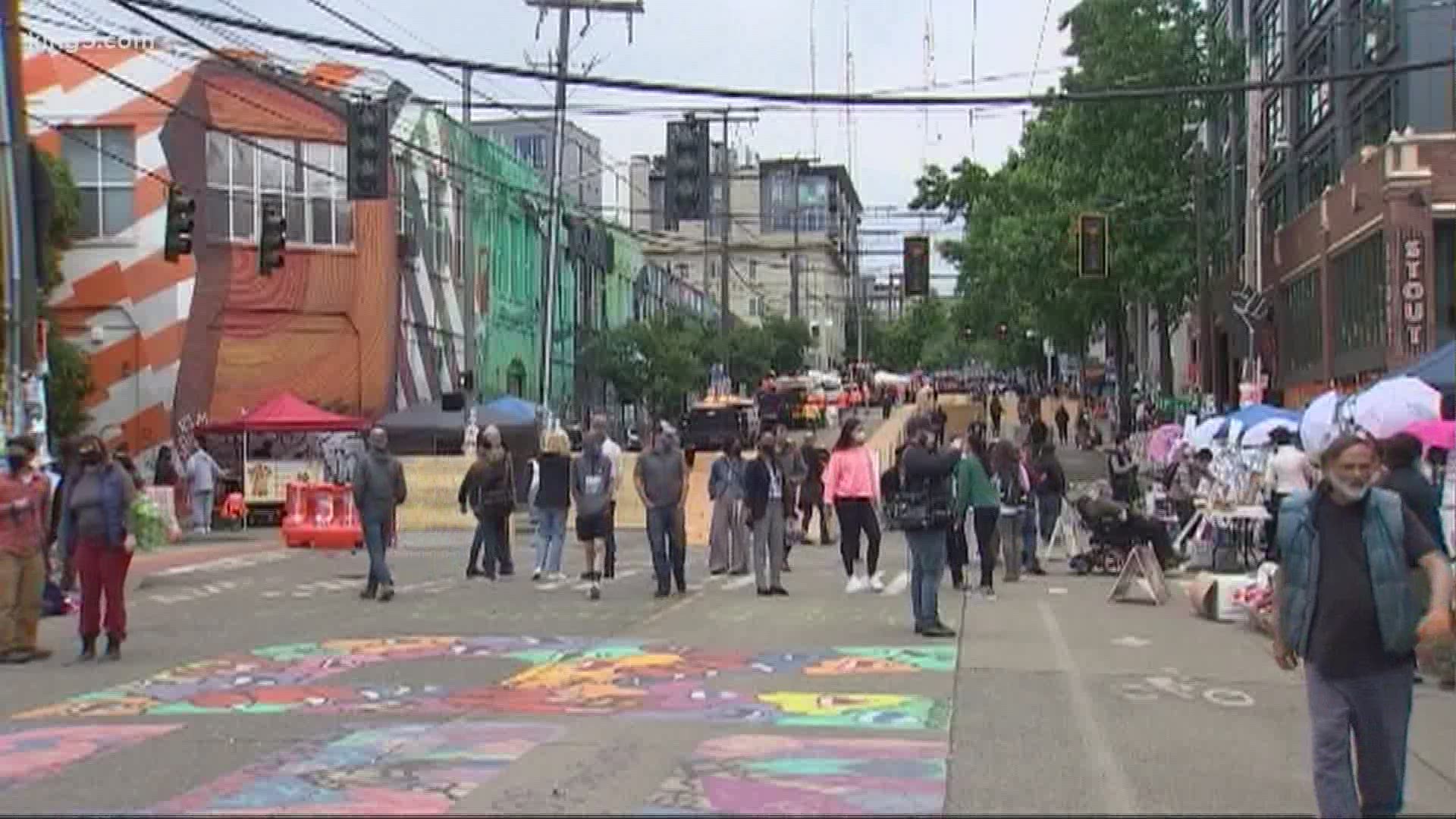SEATTLE — On Tuesday, crews from the Seattle Department of Transportation moved existing barriers and installed new ones, in an effort to open up part of "CHOP" – short for "Capitol Hill Organized Protest," and formerly known as the "Capitol Hill Autonomous Zone."
The ongoing protest had been blocking several streets in front of the Seattle Police East Precinct.
Crews started early in the morning, and installed concrete barriers wrapped in plywood down the middle of 12th Avenue, and turning onto the section of Pine Street in front of the emptied precinct.
A tent barrier was also removed at 10th and Pine, and replaced with concrete, and an alley access zone put in on the south side of Pine between 11th and 12th for apartment access.
Officials have previously raised concerns about access for emergency crews inside CHOP, formerly called "CHAZ" – the "Capitol Hill Autonomous Zone." Protestors have blocked off several blocks of Capitol Hill, after police left the East Precinct building.
“I’m a little conflicted about it,” said one passer-by. “I liked it being an autonomous zone, I understand the necessity for that – but I think it takes a little way. But again that’s a hard thing to judge.”
The city hopes the barriers will preserve people’s right to protest in the space, protect people gathering in the area, and open up part of the road for residents and businesses.
Seattle police said it will still respond to “significant life-safety issues” in the area.
SDOT and Fire Chief Harold Scoggins met with protestors previously to discuss the plan, city officials said. Though as the barriers went up Tuesday, not all were pleased to see the way it was implemented.
“The conversation we had yesterday is not what we’re seeing developed here today," said a protestor calling herself J. "So we’re strategizing as to how we will expand, as well as contain the situation that you’re currently seeing.”
She said access for fire and EMS in a "non-political space" is acceptable – but that they plan to block access to the partially opened sections after 10 p.m.
“And since, in a way, they are taking up some of our space, we’re going to continue expanding out and will be occupying the backside of Cal Anderson (Park) and that whole additional block,” J said.
Additional plans have been formulated to allow access for emergency personnel, according to the city.
Scoggins spoke to reporters on Tuesday about the street changes.
"It means a lot to try to create a safe space for people, that's the business that I'm in," Scoggins said. "But it also means a lot for people to be heard."
City officials held a meeting with protest organizers, businesses, and residents on Sunday to discuss proposed changes.
Work began Tuesday morning to remove a tent barrier at 10th Avenue and Pine Street and replace it with a concrete barrier. The protest zone has also been reconfigured to allow for better access for the community.
The area adjacent to Cal Anderson Park on Pine between 10th and 11th Avenues remains closed for Black Lives Matter street art.
Meanwhile, 12th Avenue is becoming a one-way street south of Pine, in order to accommodate the protest zone in the west lanes.
According to the city, the Seattle Police Department will dispatch to respond to significant life-safety issues in the area, including active shooters, assaults, fires, and medical emergencies.
"Preserving a space for demonstrators to come together is one of several actions the City has taken to respond to the community’s call for change," a statement from the city reads.
The statement also mentioned changes Seattle Police Department
"Over the last two weeks, Mayor Durkan has prioritized meeting with community leaders and demonstration organizers, heard their concerns, and is committed to enduring systemic changes to reimagine what policing looks like in Seattle and to addressing systemic racism. Thus far, community voices have led to new Seattle Police Department (SPD) protocol on mourning badges and body cameras, has led the state to move towards creating a Statewide Independent Investigation for officers who use deadly force, and much more. Prior to the CHOP forming, the Mayor also committed to investing $100 million directly into community and creating a community-driven Black Commission. The City recognizes that more must be done, and the Mayor and department leaders are committed to that work."

